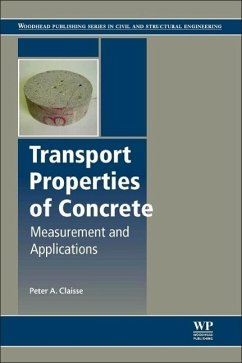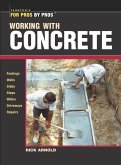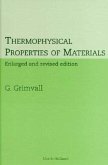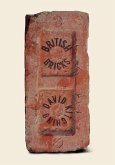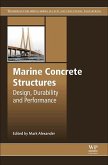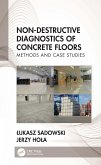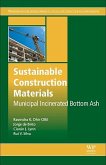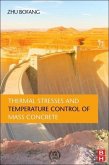Peter A. Claisse (UK Coventry University)
Transport Properties of Concrete
Measurements and Applications
Peter A. Claisse (UK Coventry University)
Transport Properties of Concrete
Measurements and Applications
- Gebundenes Buch
- Merkliste
- Auf die Merkliste
- Bewerten Bewerten
- Teilen
- Produkt teilen
- Produkterinnerung
- Produkterinnerung
This book is a monograph based on research published by the author in a number of different journals. The computer models which are presented are all written in basic code-no propriety packages were used other than Excel spreadsheets. The key parts of the code are presented and the methods used to develop them are explained.
Andere Kunden interessierten sich auch für
![Working with Concrete Working with Concrete]() R ArnoldWorking with Concrete21,99 €
R ArnoldWorking with Concrete21,99 €![Thermophysical Properties of Materials Thermophysical Properties of Materials]() G. GrimvallThermophysical Properties of Materials348,99 €
G. GrimvallThermophysical Properties of Materials348,99 €![British Bricks British Bricks]() David KitchingBritish Bricks19,99 €
David KitchingBritish Bricks19,99 €![Marine Concrete Structures Marine Concrete Structures]() Marine Concrete Structures261,99 €
Marine Concrete Structures261,99 €![Non-Destructive Diagnostics of Concrete Floors Non-Destructive Diagnostics of Concrete Floors]() Lukasz SadowskiNon-Destructive Diagnostics of Concrete Floors93,99 €
Lukasz SadowskiNon-Destructive Diagnostics of Concrete Floors93,99 €![Sustainable Construction Materials Sustainable Construction Materials]() Ravindra K. Dhir OBESustainable Construction Materials241,99 €
Ravindra K. Dhir OBESustainable Construction Materials241,99 €![Thermal Stresses and Temperature Control of Mass Concrete Thermal Stresses and Temperature Control of Mass Concrete]() Zhu BofangThermal Stresses and Temperature Control of Mass Concrete208,99 €
Zhu BofangThermal Stresses and Temperature Control of Mass Concrete208,99 €-
-
-
This book is a monograph based on research published by the author in a number of different journals. The computer models which are presented are all written in basic code-no propriety packages were used other than Excel spreadsheets. The key parts of the code are presented and the methods used to develop them are explained.
Hinweis: Dieser Artikel kann nur an eine deutsche Lieferadresse ausgeliefert werden.
Hinweis: Dieser Artikel kann nur an eine deutsche Lieferadresse ausgeliefert werden.
Produktdetails
- Produktdetails
- Verlag: Elsevier Science & Technology
- Seitenzahl: 312
- Erscheinungstermin: 20. Mai 2014
- Englisch
- Abmessung: 241mm x 161mm x 25mm
- Gewicht: 636g
- ISBN-13: 9781782423065
- ISBN-10: 1782423060
- Artikelnr.: 40511473
- Herstellerkennzeichnung
- Libri GmbH
- Europaallee 1
- 36244 Bad Hersfeld
- gpsr@libri.de
- Verlag: Elsevier Science & Technology
- Seitenzahl: 312
- Erscheinungstermin: 20. Mai 2014
- Englisch
- Abmessung: 241mm x 161mm x 25mm
- Gewicht: 636g
- ISBN-13: 9781782423065
- ISBN-10: 1782423060
- Artikelnr.: 40511473
- Herstellerkennzeichnung
- Libri GmbH
- Europaallee 1
- 36244 Bad Hersfeld
- gpsr@libri.de
Peter A. Claisse is Professor Emeritus at Coventry University and the author of more than 100 publications on construction and materials, including the Woodhead title Transport Properties of Concrete: Measurements and Applications. He graduated with a degree in Physics from Oxford University and then spent the next 9 years working as a Civil Engineer on major UK construction sites including 4 years on the Torness nuclear power station.¿After obtaining a PhD in Civil Engineering at Leeds University, studying Silica Fume in concrete, he then went to the AEA Technology Harwell laboratory for 3 years to work on Nuclear waste containment.¿He was at Coventry University for 20 years, teaching Civil Engineering Materials and researching transport processes in concrete and the use of secondary materials in cement.
1. Author contact details
2. Woodhead Publishing Series in Civil and Structural Engineering
3. Introduction
* The fundamental equations
* Computer codes
* Structure of this book
* Experimental data
* Summary of contents
* References
4. Acknowledgements
5. 1. The transport properties of concrete and the equations that describe
them
* Abstract:
* 1.1 Introduction
* 1.2 The transport processes
* 1.3 Processes which increase or reduce the transport
* 1.4 Conclusions
* 1.5 References
6. 2. Computer models to predict the transport processes in concrete
* Abstract:
* 2.1 Introduction
* 2.2 Expressing the basic equations as computer code
* 2.3 Other elements of the code
* 2.4 Example: calculations for a waste containment barrier
* 2.5 Conclusions
* 2.6 Reference
7. 3. Surface tests to determine transport properties of concrete - I: the
tests
* Abstract:
* 3.1 Introduction
* 3.2 The initial surface absorption test (ISAT)
* 3.3 The Figg air permeation index
* 3.4 Other tests
* 3.5 Vacuum preconditioning: a development of the ISAT test
* 3.6 Vacuum preconditioning for other tests
* 3.7 Conclusions
* 3.7 References
8. 4. Surface tests to determine transport properties of concrete - II:
analytical models to calculate permeability
* Abstract:
* 4.1 Introduction
* 4.2 Additional tests
* 4.3 Modelling of the absorption tests
* 4.4 Experimental testing for absorption
* 4.5 Tests using a vacuum to measure air flow
* 4.6 The choice of test for practical applications
* 4.7 Conclusions
* 4.8 References
9. 5. Surface tests to determine transport properties of concrete - III:
measuring gas permeability
* Abstract:
* 5.1 Introduction
* 5.2 Theoretical analysis
* 5.3 Investigation of methods for sealing the drilled holes
* 5.4 Determination of pressure decay profile
* 5.5 Comparison of in situ test methods
* 5.6 Conclusions
* 5.7 References
10. 6. Measurements of gas migration in concrete
* Abstract:
* 6.1 Introduction
* 6.2 Experimental method
* 6.3 Analysis of experimental data
* 6.4 Results for gas permeability of concrete
* 6.5 Comparison with gas permeability of grouts
* 6.6 The effect of interfaces on gas permeability
* 6.7 Discussion
* 6.8 Conclusions
* 6.9 Reference
11. 7. Water vapour and liquid permeability measurements in concrete
* Abstract
* 7.1 Introduction
* 7.2 Experimental methods
* 7.3 Methods of analysis of results
* 7.4 Results and discussion
* 7.5 Conclusions
* 7.6 References
12. 8. Measurement of porosity as a predictor of the transport properties of
concrete
* Abstract:
* 8.1 Introduction
* 8.2 Sample preparation and testing programme
* 8.3 Tests for porosity
* 8.4 Tests for properties controlled by transport
* 8.5 Oxygen transport
* 8.6 Vapour transport
* 8.7 Results and discussion
* 8.8 Conclusions
* 8.9 References
13. 9. Factors affecting the measurement of the permeability of concrete
* Abstract:
* 9.1 Introduction
* 9.2 Experimental programme
* 9.3 Results
* 9.4 Discussion
* 9.5 Conclusions
* 9.6 References
14. 10. Electrical tests to analyse the transport properties of concrete - I:
modelling diffusion and electromigration
* Abstract
* 10.1 Introduction
* 10.2 The ASTM C1202 test and the salt bridge
* 10.3 The physical processes
* 10.4 Analytical solutions
* 10.5 The computer model
* 10.6 Initial experimental validation
* 10.7 Full model validation
* 10.8 Conclusions
* 10.9 References
15. 11. Electrical tests to analyse the transport properties of concrete - II:
using a neural network model to derive diffusion coefficients
* Abstract:
* 11.1 Introduction
* 11.2 Experimental method
* 11.3 Neural network optimisation model
* 11.4 Results and discussion
* 11.5 Conclusions
* 11.6 References
16. 12. Electrical tests to analyse the fundamental transport properties of
concrete - III: modelling tests without applied voltages
* Abstract:
* 12.1 Introduction
* 12.2 Test methods
* 12.3 The analytical solution
* 12.4 Computer modelling - theoretical background
* 12.5 Experimental programme
* 12.6 Results and discussion
* 12.7 Conclusions
* 12.8 References
17. 13. Applications using measured values of the transport properties of
concrete I: predicting the durability of reinforced concrete
* Abstract
* 13.1 Introduction
* 13.2 Controlling parameters for concrete durability
* 13.3 Measuring corrosion of reinforcement
* 13.4 Correlating transport measurements with corrosion
* 13.5 Predictive models for corrosion
* 13.6 Conclusions
* 13.7 References
18. 14. Applications using measured values of the transport properties of
concrete II: modelling the effect of gas pressure
* Abstract:
* 14.1 Introduction
* 14.2 Background: mechanisms of gas migration
* 14.3 The effects of stress generation in cementitious materials
* 14.4 Sensitivity to material properties and conditions
* 14.5 Behaviour in a repository
* 14.6 Conclusions
* 14.7 References
19. 15. Applications using measured values of the transport properties of
concrete - III: predicting the transport of liquids through concrete
barriers for waste containment
* Abstract:
* 15.1 Introduction
* 15.2 The computer model
* 15.3 Laboratory testing
* 15.4 Site trials
* 15.5 Reducing transport in cracked concrete
* 15.6 Conclusions
* 15.7 References
20. Conclusions, recommendations and guidance for measuring transport
properties of concrete
* The state of the art
* Recommendations and guidance
21. Appendix 1: List of papers for the experimental data and derivations
22. Appendix 2: Notation and abbreviations
* Notation
* Abbreviations
23. Index
2. Woodhead Publishing Series in Civil and Structural Engineering
3. Introduction
* The fundamental equations
* Computer codes
* Structure of this book
* Experimental data
* Summary of contents
* References
4. Acknowledgements
5. 1. The transport properties of concrete and the equations that describe
them
* Abstract:
* 1.1 Introduction
* 1.2 The transport processes
* 1.3 Processes which increase or reduce the transport
* 1.4 Conclusions
* 1.5 References
6. 2. Computer models to predict the transport processes in concrete
* Abstract:
* 2.1 Introduction
* 2.2 Expressing the basic equations as computer code
* 2.3 Other elements of the code
* 2.4 Example: calculations for a waste containment barrier
* 2.5 Conclusions
* 2.6 Reference
7. 3. Surface tests to determine transport properties of concrete - I: the
tests
* Abstract:
* 3.1 Introduction
* 3.2 The initial surface absorption test (ISAT)
* 3.3 The Figg air permeation index
* 3.4 Other tests
* 3.5 Vacuum preconditioning: a development of the ISAT test
* 3.6 Vacuum preconditioning for other tests
* 3.7 Conclusions
* 3.7 References
8. 4. Surface tests to determine transport properties of concrete - II:
analytical models to calculate permeability
* Abstract:
* 4.1 Introduction
* 4.2 Additional tests
* 4.3 Modelling of the absorption tests
* 4.4 Experimental testing for absorption
* 4.5 Tests using a vacuum to measure air flow
* 4.6 The choice of test for practical applications
* 4.7 Conclusions
* 4.8 References
9. 5. Surface tests to determine transport properties of concrete - III:
measuring gas permeability
* Abstract:
* 5.1 Introduction
* 5.2 Theoretical analysis
* 5.3 Investigation of methods for sealing the drilled holes
* 5.4 Determination of pressure decay profile
* 5.5 Comparison of in situ test methods
* 5.6 Conclusions
* 5.7 References
10. 6. Measurements of gas migration in concrete
* Abstract:
* 6.1 Introduction
* 6.2 Experimental method
* 6.3 Analysis of experimental data
* 6.4 Results for gas permeability of concrete
* 6.5 Comparison with gas permeability of grouts
* 6.6 The effect of interfaces on gas permeability
* 6.7 Discussion
* 6.8 Conclusions
* 6.9 Reference
11. 7. Water vapour and liquid permeability measurements in concrete
* Abstract
* 7.1 Introduction
* 7.2 Experimental methods
* 7.3 Methods of analysis of results
* 7.4 Results and discussion
* 7.5 Conclusions
* 7.6 References
12. 8. Measurement of porosity as a predictor of the transport properties of
concrete
* Abstract:
* 8.1 Introduction
* 8.2 Sample preparation and testing programme
* 8.3 Tests for porosity
* 8.4 Tests for properties controlled by transport
* 8.5 Oxygen transport
* 8.6 Vapour transport
* 8.7 Results and discussion
* 8.8 Conclusions
* 8.9 References
13. 9. Factors affecting the measurement of the permeability of concrete
* Abstract:
* 9.1 Introduction
* 9.2 Experimental programme
* 9.3 Results
* 9.4 Discussion
* 9.5 Conclusions
* 9.6 References
14. 10. Electrical tests to analyse the transport properties of concrete - I:
modelling diffusion and electromigration
* Abstract
* 10.1 Introduction
* 10.2 The ASTM C1202 test and the salt bridge
* 10.3 The physical processes
* 10.4 Analytical solutions
* 10.5 The computer model
* 10.6 Initial experimental validation
* 10.7 Full model validation
* 10.8 Conclusions
* 10.9 References
15. 11. Electrical tests to analyse the transport properties of concrete - II:
using a neural network model to derive diffusion coefficients
* Abstract:
* 11.1 Introduction
* 11.2 Experimental method
* 11.3 Neural network optimisation model
* 11.4 Results and discussion
* 11.5 Conclusions
* 11.6 References
16. 12. Electrical tests to analyse the fundamental transport properties of
concrete - III: modelling tests without applied voltages
* Abstract:
* 12.1 Introduction
* 12.2 Test methods
* 12.3 The analytical solution
* 12.4 Computer modelling - theoretical background
* 12.5 Experimental programme
* 12.6 Results and discussion
* 12.7 Conclusions
* 12.8 References
17. 13. Applications using measured values of the transport properties of
concrete I: predicting the durability of reinforced concrete
* Abstract
* 13.1 Introduction
* 13.2 Controlling parameters for concrete durability
* 13.3 Measuring corrosion of reinforcement
* 13.4 Correlating transport measurements with corrosion
* 13.5 Predictive models for corrosion
* 13.6 Conclusions
* 13.7 References
18. 14. Applications using measured values of the transport properties of
concrete II: modelling the effect of gas pressure
* Abstract:
* 14.1 Introduction
* 14.2 Background: mechanisms of gas migration
* 14.3 The effects of stress generation in cementitious materials
* 14.4 Sensitivity to material properties and conditions
* 14.5 Behaviour in a repository
* 14.6 Conclusions
* 14.7 References
19. 15. Applications using measured values of the transport properties of
concrete - III: predicting the transport of liquids through concrete
barriers for waste containment
* Abstract:
* 15.1 Introduction
* 15.2 The computer model
* 15.3 Laboratory testing
* 15.4 Site trials
* 15.5 Reducing transport in cracked concrete
* 15.6 Conclusions
* 15.7 References
20. Conclusions, recommendations and guidance for measuring transport
properties of concrete
* The state of the art
* Recommendations and guidance
21. Appendix 1: List of papers for the experimental data and derivations
22. Appendix 2: Notation and abbreviations
* Notation
* Abbreviations
23. Index
1. Author contact details
2. Woodhead Publishing Series in Civil and Structural Engineering
3. Introduction
* The fundamental equations
* Computer codes
* Structure of this book
* Experimental data
* Summary of contents
* References
4. Acknowledgements
5. 1. The transport properties of concrete and the equations that describe
them
* Abstract:
* 1.1 Introduction
* 1.2 The transport processes
* 1.3 Processes which increase or reduce the transport
* 1.4 Conclusions
* 1.5 References
6. 2. Computer models to predict the transport processes in concrete
* Abstract:
* 2.1 Introduction
* 2.2 Expressing the basic equations as computer code
* 2.3 Other elements of the code
* 2.4 Example: calculations for a waste containment barrier
* 2.5 Conclusions
* 2.6 Reference
7. 3. Surface tests to determine transport properties of concrete - I: the
tests
* Abstract:
* 3.1 Introduction
* 3.2 The initial surface absorption test (ISAT)
* 3.3 The Figg air permeation index
* 3.4 Other tests
* 3.5 Vacuum preconditioning: a development of the ISAT test
* 3.6 Vacuum preconditioning for other tests
* 3.7 Conclusions
* 3.7 References
8. 4. Surface tests to determine transport properties of concrete - II:
analytical models to calculate permeability
* Abstract:
* 4.1 Introduction
* 4.2 Additional tests
* 4.3 Modelling of the absorption tests
* 4.4 Experimental testing for absorption
* 4.5 Tests using a vacuum to measure air flow
* 4.6 The choice of test for practical applications
* 4.7 Conclusions
* 4.8 References
9. 5. Surface tests to determine transport properties of concrete - III:
measuring gas permeability
* Abstract:
* 5.1 Introduction
* 5.2 Theoretical analysis
* 5.3 Investigation of methods for sealing the drilled holes
* 5.4 Determination of pressure decay profile
* 5.5 Comparison of in situ test methods
* 5.6 Conclusions
* 5.7 References
10. 6. Measurements of gas migration in concrete
* Abstract:
* 6.1 Introduction
* 6.2 Experimental method
* 6.3 Analysis of experimental data
* 6.4 Results for gas permeability of concrete
* 6.5 Comparison with gas permeability of grouts
* 6.6 The effect of interfaces on gas permeability
* 6.7 Discussion
* 6.8 Conclusions
* 6.9 Reference
11. 7. Water vapour and liquid permeability measurements in concrete
* Abstract
* 7.1 Introduction
* 7.2 Experimental methods
* 7.3 Methods of analysis of results
* 7.4 Results and discussion
* 7.5 Conclusions
* 7.6 References
12. 8. Measurement of porosity as a predictor of the transport properties of
concrete
* Abstract:
* 8.1 Introduction
* 8.2 Sample preparation and testing programme
* 8.3 Tests for porosity
* 8.4 Tests for properties controlled by transport
* 8.5 Oxygen transport
* 8.6 Vapour transport
* 8.7 Results and discussion
* 8.8 Conclusions
* 8.9 References
13. 9. Factors affecting the measurement of the permeability of concrete
* Abstract:
* 9.1 Introduction
* 9.2 Experimental programme
* 9.3 Results
* 9.4 Discussion
* 9.5 Conclusions
* 9.6 References
14. 10. Electrical tests to analyse the transport properties of concrete - I:
modelling diffusion and electromigration
* Abstract
* 10.1 Introduction
* 10.2 The ASTM C1202 test and the salt bridge
* 10.3 The physical processes
* 10.4 Analytical solutions
* 10.5 The computer model
* 10.6 Initial experimental validation
* 10.7 Full model validation
* 10.8 Conclusions
* 10.9 References
15. 11. Electrical tests to analyse the transport properties of concrete - II:
using a neural network model to derive diffusion coefficients
* Abstract:
* 11.1 Introduction
* 11.2 Experimental method
* 11.3 Neural network optimisation model
* 11.4 Results and discussion
* 11.5 Conclusions
* 11.6 References
16. 12. Electrical tests to analyse the fundamental transport properties of
concrete - III: modelling tests without applied voltages
* Abstract:
* 12.1 Introduction
* 12.2 Test methods
* 12.3 The analytical solution
* 12.4 Computer modelling - theoretical background
* 12.5 Experimental programme
* 12.6 Results and discussion
* 12.7 Conclusions
* 12.8 References
17. 13. Applications using measured values of the transport properties of
concrete I: predicting the durability of reinforced concrete
* Abstract
* 13.1 Introduction
* 13.2 Controlling parameters for concrete durability
* 13.3 Measuring corrosion of reinforcement
* 13.4 Correlating transport measurements with corrosion
* 13.5 Predictive models for corrosion
* 13.6 Conclusions
* 13.7 References
18. 14. Applications using measured values of the transport properties of
concrete II: modelling the effect of gas pressure
* Abstract:
* 14.1 Introduction
* 14.2 Background: mechanisms of gas migration
* 14.3 The effects of stress generation in cementitious materials
* 14.4 Sensitivity to material properties and conditions
* 14.5 Behaviour in a repository
* 14.6 Conclusions
* 14.7 References
19. 15. Applications using measured values of the transport properties of
concrete - III: predicting the transport of liquids through concrete
barriers for waste containment
* Abstract:
* 15.1 Introduction
* 15.2 The computer model
* 15.3 Laboratory testing
* 15.4 Site trials
* 15.5 Reducing transport in cracked concrete
* 15.6 Conclusions
* 15.7 References
20. Conclusions, recommendations and guidance for measuring transport
properties of concrete
* The state of the art
* Recommendations and guidance
21. Appendix 1: List of papers for the experimental data and derivations
22. Appendix 2: Notation and abbreviations
* Notation
* Abbreviations
23. Index
2. Woodhead Publishing Series in Civil and Structural Engineering
3. Introduction
* The fundamental equations
* Computer codes
* Structure of this book
* Experimental data
* Summary of contents
* References
4. Acknowledgements
5. 1. The transport properties of concrete and the equations that describe
them
* Abstract:
* 1.1 Introduction
* 1.2 The transport processes
* 1.3 Processes which increase or reduce the transport
* 1.4 Conclusions
* 1.5 References
6. 2. Computer models to predict the transport processes in concrete
* Abstract:
* 2.1 Introduction
* 2.2 Expressing the basic equations as computer code
* 2.3 Other elements of the code
* 2.4 Example: calculations for a waste containment barrier
* 2.5 Conclusions
* 2.6 Reference
7. 3. Surface tests to determine transport properties of concrete - I: the
tests
* Abstract:
* 3.1 Introduction
* 3.2 The initial surface absorption test (ISAT)
* 3.3 The Figg air permeation index
* 3.4 Other tests
* 3.5 Vacuum preconditioning: a development of the ISAT test
* 3.6 Vacuum preconditioning for other tests
* 3.7 Conclusions
* 3.7 References
8. 4. Surface tests to determine transport properties of concrete - II:
analytical models to calculate permeability
* Abstract:
* 4.1 Introduction
* 4.2 Additional tests
* 4.3 Modelling of the absorption tests
* 4.4 Experimental testing for absorption
* 4.5 Tests using a vacuum to measure air flow
* 4.6 The choice of test for practical applications
* 4.7 Conclusions
* 4.8 References
9. 5. Surface tests to determine transport properties of concrete - III:
measuring gas permeability
* Abstract:
* 5.1 Introduction
* 5.2 Theoretical analysis
* 5.3 Investigation of methods for sealing the drilled holes
* 5.4 Determination of pressure decay profile
* 5.5 Comparison of in situ test methods
* 5.6 Conclusions
* 5.7 References
10. 6. Measurements of gas migration in concrete
* Abstract:
* 6.1 Introduction
* 6.2 Experimental method
* 6.3 Analysis of experimental data
* 6.4 Results for gas permeability of concrete
* 6.5 Comparison with gas permeability of grouts
* 6.6 The effect of interfaces on gas permeability
* 6.7 Discussion
* 6.8 Conclusions
* 6.9 Reference
11. 7. Water vapour and liquid permeability measurements in concrete
* Abstract
* 7.1 Introduction
* 7.2 Experimental methods
* 7.3 Methods of analysis of results
* 7.4 Results and discussion
* 7.5 Conclusions
* 7.6 References
12. 8. Measurement of porosity as a predictor of the transport properties of
concrete
* Abstract:
* 8.1 Introduction
* 8.2 Sample preparation and testing programme
* 8.3 Tests for porosity
* 8.4 Tests for properties controlled by transport
* 8.5 Oxygen transport
* 8.6 Vapour transport
* 8.7 Results and discussion
* 8.8 Conclusions
* 8.9 References
13. 9. Factors affecting the measurement of the permeability of concrete
* Abstract:
* 9.1 Introduction
* 9.2 Experimental programme
* 9.3 Results
* 9.4 Discussion
* 9.5 Conclusions
* 9.6 References
14. 10. Electrical tests to analyse the transport properties of concrete - I:
modelling diffusion and electromigration
* Abstract
* 10.1 Introduction
* 10.2 The ASTM C1202 test and the salt bridge
* 10.3 The physical processes
* 10.4 Analytical solutions
* 10.5 The computer model
* 10.6 Initial experimental validation
* 10.7 Full model validation
* 10.8 Conclusions
* 10.9 References
15. 11. Electrical tests to analyse the transport properties of concrete - II:
using a neural network model to derive diffusion coefficients
* Abstract:
* 11.1 Introduction
* 11.2 Experimental method
* 11.3 Neural network optimisation model
* 11.4 Results and discussion
* 11.5 Conclusions
* 11.6 References
16. 12. Electrical tests to analyse the fundamental transport properties of
concrete - III: modelling tests without applied voltages
* Abstract:
* 12.1 Introduction
* 12.2 Test methods
* 12.3 The analytical solution
* 12.4 Computer modelling - theoretical background
* 12.5 Experimental programme
* 12.6 Results and discussion
* 12.7 Conclusions
* 12.8 References
17. 13. Applications using measured values of the transport properties of
concrete I: predicting the durability of reinforced concrete
* Abstract
* 13.1 Introduction
* 13.2 Controlling parameters for concrete durability
* 13.3 Measuring corrosion of reinforcement
* 13.4 Correlating transport measurements with corrosion
* 13.5 Predictive models for corrosion
* 13.6 Conclusions
* 13.7 References
18. 14. Applications using measured values of the transport properties of
concrete II: modelling the effect of gas pressure
* Abstract:
* 14.1 Introduction
* 14.2 Background: mechanisms of gas migration
* 14.3 The effects of stress generation in cementitious materials
* 14.4 Sensitivity to material properties and conditions
* 14.5 Behaviour in a repository
* 14.6 Conclusions
* 14.7 References
19. 15. Applications using measured values of the transport properties of
concrete - III: predicting the transport of liquids through concrete
barriers for waste containment
* Abstract:
* 15.1 Introduction
* 15.2 The computer model
* 15.3 Laboratory testing
* 15.4 Site trials
* 15.5 Reducing transport in cracked concrete
* 15.6 Conclusions
* 15.7 References
20. Conclusions, recommendations and guidance for measuring transport
properties of concrete
* The state of the art
* Recommendations and guidance
21. Appendix 1: List of papers for the experimental data and derivations
22. Appendix 2: Notation and abbreviations
* Notation
* Abbreviations
23. Index

